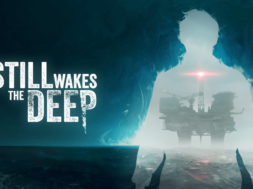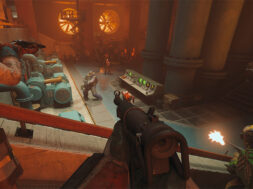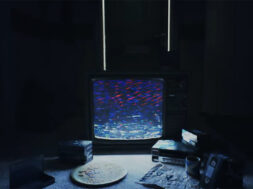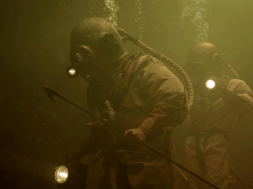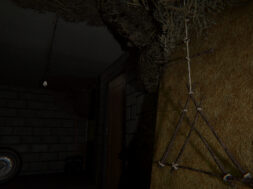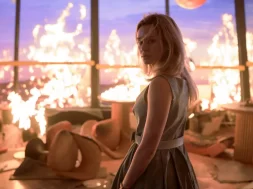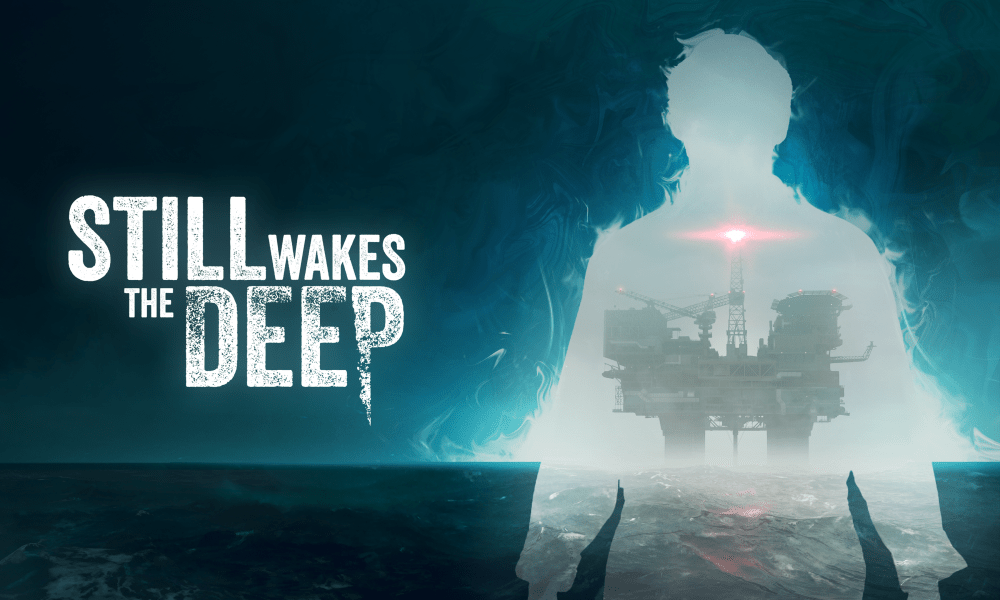
Prior to booting up Still Wakes the Deep, you’re confronted with the usual suite of options that you’d expect to find in any contemporary videogame. It’s your opportunity to customise things like the gamma levels, the assorted presentation settings, your HUD preferences and of course, the language that you’ll be hearing throughout the ensuing 5-hour campaign.
However, one thing in particular caught my eye over in the subtitling menu. You see, there are two alternative sets of captions for English speakers here. There’s the default version, which takes some editorial liberties in order to translate dialogue into Received Pronunciation, and then there’s the “English (United Kingdom)” variant, which offers a far more faithful, verbatim transcript of the words that are actually coming out of characters’ mouths.
The rationale behind this is that the cast of Still Wakes the Deep is predominately Scottish, with a couple of Yorkshiremen (like yours truly) thrown into the mix. And, as such, they have a very specific way of speaking. One that is easily interpreted by those of us who are accustomed to grey-sky summers and year-round drizzle, but might pose a bit of a challenge for players hailing from other territories.
Don’t get me wrong, you needn’t be a linguist to get to the bottom of some of the regionalisms and turns of phrase here. From context alone, you should be able to infer that “leccy” is a contraction of “electricity” and that “me old mucker” is a friendly term of endearment. Nor will you have to consult a glossary in order to discern that “numpty” means “idiot” — when deployed to teasingly scold a colleague — or that “blotted” is slang for drunk. In fact, as a good rule of thumb, just assume that any unfamiliar adjective ending with “ed” somehow describes a state of inebriation.
Yet other vocab might prove a little trickier to wrap your head around if you’re not a Brit. For instance, when one character urges you to deal with a problem before “his nibs blows a casket”, no one would blame you for wondering what the fuck they’re on about. Similarly, you might be confused about what relevance “blue-arsed flies” have in a survival situation or what qualifies someone to be “jammy.”
That’s where those handy subtitles come in, decoding the more obscure lexicon so that everyone can follow along with the story. Although I will admit, as someone who experimented with both caption options for the sake of this review, it can be quite funny when there’s no logical, plain English equivalent to what’s being said!
On a more serious point, I really appreciated how Still Wakes the Deep sticks to its guns with the regional dialogue. I rarely get to hear characters who sound like my own friends and family in videogames and, whenever I do, they’re typically relegated to background roles in medieval fantasy RPGs. The most they can aspire to be is bandits, beggars and wandering nomads.
Yet working-class Scots and Northerners are cast as the heroes of the piece here and allowed to speak with their authentic voices. Excessive C-bombs and all.
Writer Dan Pinchbeck clearly wasn’t fretting over whether people would be put off by this direction and instead leaned into it to capture a vivid sense of time and place. The end result is a game that’s got personality to spare; helping it stand out from all of the horror releases on the marketplace today.
‘Annihilation’ Meets ‘The Poseidon Adventure’
Speaking of which, and contrary to the impression that preamble might have given you, Still Wakes the Deep is not some ultra-grounded kitchen sink drama.
Rather, it is a full-blooded horror experience — in the vein of Amnesia or Outlast— that just so happens to come from a fresh point of view. Class is definitely an underlying theme that cannot be ignored, but it’s also got big scary monsters, ample buckets of gore and some of the most intense sequences we’ve played in recent memory.
Brought to you by The Chinese Room (whose previous credits include Dear Esther and Everybody’s Gone to the Rapture), there are traces of the walking-sim genre in its DNA for sure. However, that is complimented by some proper stealth mechanics and exhilarating chases, which add up to make this the developer’s most interactive outing yet.
In a nutshell, the elevator pitch is “Annihilation by way of The Poseidon Adventure” and if that doesn’t pique your interest then we’re not sure what will. Set in December 1975, the game puts you in the steel-toed boots of Cameron “Caz” McLeary, an electrician who is stationed on the Beira D oil drilling platform; based somewhere out in the North Sea.
The reason Caz has taken on such an undesirable gig is to escape the repercussions of an undisclosed crime that he committed back on the mainland. He does have a wife and kid waiting for him back home, but you get the impression that those relationships have soured lately, on account of him now being a wanted felon.
Anyway, McLeary toils away on the rig, enduring harsh weather conditions and equally harsh treatment from the foreman in charge. That is until, one day, his past finally catches up with him and he’s forced to take accountability for his actions.
Or he would be, were it not a serendipitous calamity that plunges the Beira D into absolute chaos just as he’s about to face the music. It seems that the team hit something unexpected in their routine drilling operations and now the whole facility is on fire and rapidly sinking into the ocean.
Not to mention, they’ve disturbed a terrible entity that is now picking off the crew; absorbing them into its own organic structure, fusing them to corridors and, in some cases, splicing them together into unholy hybrids. If you’ve seen Annihilation, you’ll apprehend what’s happening pretty quickly.
What follows is a desperate fight for survival that’s unsettling, dramatically involving, visually spectacular and, towards the climax, surprisingly moving. Even if there are occasional bumps along the road.
Stepping Into The Past
In addition to nailing that Glaswegian tongue, Still Wakes the Deep has remarkable attention to detail across the board. One that can be felt in every nanosecond of its tightly paced campaign.
We’re not just talking about graphical fidelity either (although, granted, that too is exemplary; with you being able to scrutinise assets up close to reveal things like: the blistered paint of a dormitory wall; ladder rungs that are crisscrossed with scratch marks; or worn safety railings that have gradually succumbed to the elements). Indeed, while the game is no slouch in the visual department, what’s most impressive about it is the meticulousness with which it evokes a very precise time & place.
As with those dialectal nuances that have been so carefully baked into the script, the environmental touches here might not have the same resonance for overseas audiences. Hell, there’s probably a bunch of Scotland-specific references that go over my head and I only live a couple of hours to the South!
Yet regardless of how familiar you are with ’70s Britain — a grim decade defined by its austerity measures, labour disputes, government-mandated power cuts, ugly political divides and even uglier curtains — the Chinese Room will be able to transport you there. Because much like 2022’s Martha is Dead, Still Wakes the Deep could almost pass for an interactive museum exhibit; such is its commitment to historical accuracy. You know, until the mutant beasties show up!
The Beira D’s communal areas are particularly evocative time capsules. Era-appropriate newspaper headlines give you an idea of what’s occurring back on the mainland, those inexplicably sinister Christmas cards — that were all the rage back then — decorate the various corkboards, and paying a visit to resident jingoist Addair’s quarters will confirm any suspicious you might have had about his right-wing leanings (courtesy of a National Front poster that’s on proud display and an actual red flag, in the form of the Union Jack). Elsewhere, turning on the TV will confront you with the BBC’s notoriously creepy Test Card F transmission, and the oil rig crew warm themselves with a model of gas heater that I’m pretty certain I’ve seen in my Grandparents’ closet.
This is more than mere nostalgic porn, however, as the period setting is essential to the story. Not only does it inform the characterisation of Caz and his many colleagues (including the aforementioned bigot and the far more affable trade unionist “Trotts”) but it also plays into the central theme of class.
These are disenfranchised blue collar workers after all, barely surviving on a paycheque to paycheque basis. They’re living hand-to-mouth in a climate where the divide between Haves & Have Nots is increasingly stark. One early-game document we stumbled across revealed that they can’t even look forward to festive bonuses this year, despite being hundreds of miles away from their families during the holiday.
When the shit hits the proverbial fan then, it’s hardly surprising that these guys are deemed expendable and left to fend for themselves. To the bean counters in charge, they’re nothing more than interchangeable names on the payroll, recalling how the crew of the Nostromo were treated in Alien. Only this time we’re not glimpsing some far-flung, dystopic vision of the future, but a very tangible yesteryear. Unvarnished and with not a single punch pulled.
Hard Graft
The title certainly does a fantastic job of immersing you in Caz’s brutal working conditions. Taking cues from The Descent, it goes out of its way to make the oil rig a fundamentally terrifying place long before any paranormal complications arise.
The environment is fraught with perils that presumably come with the territory of your new 9-5. Poorly maintained drilling equipment swings around wildly in the tempestuous gales and safety notices warn you of every conceivable hazard under the sun — ranging from getting alkaline solutions in your eyes to being crushed beneath heavy machinery. Meanwhile, those who enter the diving bell risk contracting decompression sickness, there are pockets of flammable gas you ought to be wary of, and the very first time you venture out to the deck your head is nearly taken off by an industrial lift! And to reiterate, this is all before anything goes wrong!
You thus get a sense that the lives of Cameron and his fellow roughnecks hang in the balance each and every day; so undervalued are they by the (largely absent) company suits. It’s an awful state of affairs to begin with, but the situation only worsens with the titular waking of the deep.
On that note, while the prospect of eldritch terrors running amok in the workplace might be your number one concern following that fateful incident, you’ll also have to worry about the Beira D deteriorating around you. Taking on the role of a de facto handyman, you must frantically hurry around the rig trying to avert one engineering catastrophe after another, with the vast majority of your objectives taking the form of (oftentimes literal) firefighting.
These sections — wherein you have to fix a problem that, if left unaddressed, will cause the entire facility to explode— are the closest thing that the game has to puzzles. They never require much in the way of lateral thinking, given that the repair instructions are typically signposted nearby, but it’s nevertheless satisfying trying to follow the step-by-step protocols. Whether you’re readying the lifeboats, equalising water pressure levels, or fiddling around with safety pins, it all seems so thoroughly researched. As if you were playing a bona fide drilling simulator.
Of course, it’s not always as straightforward as just turning a few valves and pulling a lever. On the contrary, the middle aged, out-of-shape Caz will be forced to get quite acrobatic when traversing the Beria D’s crumbling infrastructure. This, in turn, leads to some of Still Wakes the Deep’s most thrilling set pieces, many of which feel like they’ve been ripped from a Hollywood disaster movie, ala The Towering Inferno.
Notable examples include vertiginous platforming sections that task you with jumping across dilapidated walkways and balancing on precarious girders, as well as a bit where you’ve got to scale a dizzying height whilst your vision is obscured by fog. One especially agonising level later on has you swimming through a flooded chamber and it’s genuinely one of the most harrowing gaming moments we’ve experienced in a while; on account of its pitch-black darkness, suffocating claustrophobia, and the lack of opportunities it gives you to surface for air. To return to those earlier Descent comparisons, it evokes the distressing cave-in scene from Neil Marshall’s film in the best possible way.
Truthfully, these scripted events are quite linear in nature and it’s hard to screw them up if you keep your cool. Yet all the same, the close calls remain nail-biting and, in terms of sheer fear factor, outshine the more traditional enemy encounters that surround them.
Audio Director Daan Hendriks’ award-worthy sound deserves a shot out here, with you being acutely aware of every metallic creak and scrape aboard the rig. Densely layered and boasting exceptional directionality, his mix conjures up all kinds of anxieties you didn’t even know you had. For instance, a faint straining noise might sow seeds of doubt in your mind about the structural integrity of a bridge, while the audible fraying of a rope indicates that something weighty is about to come loose.
It’s most effective when you’re not 100% certain what you’re hearing. Case in point, a groaning in the distance could feasibly be the howling of the wind or a pipe about to burst. Or it could equally herald the arrival of some Lovecraftian abomination intent on rending you limb from limb.
Hide and Seek On The Open Seas
Speaking of the unspeakable, the developers really make you wait for the grand debut of their hideous creations. It’s at least a quarter of the way in before you get so much as a peek at them and, even then, it’s only fleeting.
Instead, for the first 90 minutes or so, Still Wakes the Deep is all about the slow burn tease. You may hear a bloodcurdling screech echo down a corridor, or stumble across the grisly aftermath of an attack but you’ll see vanishingly little of your pursuers until the second act kicks into gear.
Honestly, it’s quite refreshing to have this kind of patient build-up in a modern videogame, given how many titles nowadays are eager to skip foreplay altogether. I’ve always respected the way Silent Hill 2 opened with a lengthy sequence of you merely strolling through a forest, all while an eerie sense of foreboding took root in the back of your mind. No action. No jump scares. No supernatural happenings of any kind. Yet it built such a masterful atmosphere and that’s exactly what The Chinese Room manages to pull off here too.
The restraint is admirable, leaving you to stew in your own juices as you imagine various worst-case scenarios for what your nemeses might look like. Based on the ungodly yet vaguely human noises they produce — and the developers having cited Annihilation as one of their primary influences — I was personally hoping for something extremely out-there and twisted. Perhaps something along the lines of that unforgettable mutant bear that went after Natalie Portman and co.
Alas, when you finally do see what’s been hot on your heels this whole time it comes as a bit of a let-down. The bland visual design doesn’t measure up to the petrifying audio that’s for sure.
The weird thing is, publisher Secret Mode has been very coy about revealing the creatures up until now; keeping them under strict embargo in previews and shying away from them in the marketing materials. Which made me hopeful that they had a super unique foe up their sleeves. In reality though, these monsters, at best, resemble naff rejects from The Thing prequel and, at worst, those gloppy stress toys that bulge outwards when you squeeze them.
It doesn’t help that they pose so little threat as well. Mostly known for their walking-sims, The Chinese Room isn’t used to crafting enemy encounters and, unfortunately, that inexperience shows in Still Wakes the Deep. While the scripted chases are pulse-pounding, stealth is incredibly basic by 2024 standards and casts us back to the days of the original Outlast.
Your interactions are limited to crouching behind obstructions, sneaking through crawlspaces and hiding in lockers. Oh, and you can also throw objects to create distractions that buy you a frankly inordinate amount of time. The enemy AI isn’t great either, with monsters being easy to outsmart and prone to getting caught on the environment. Suffice it to say, it kind of kills the tension.
Luckily, this is the only major stumbling block in what is otherwise a phenomenal package. I adored this title’s setting, its soundscape, its approach to writing and its art-direction more than enough to compensate for any foibles it may have in the gameplay arena.
Props are due for its comprehensive accessibility features too, which ensure that absolutely anybody can enjoy it. They allow you to get into the nitty gritty of customising how many words-per-minute display in the subtitles, mitigate any effects of motion sickness and (in an overdue innovation as far as the horror genre is concerned) turn off flashing lights! It’s really commendable stuff, so let’s hope other studios take note.
All in all, Still Wakes the Deep has a few blemishes but that doesn’t stop it from being one of The Chinese Room’s, and the year’s, best releases so far. Just brace yourself if you don’t like tight spaces!
Still Wakes the Deep will be on Windows PC, PlayStation 5 and Xbox Series X|S on June 18 and will launch on Game Pass.
